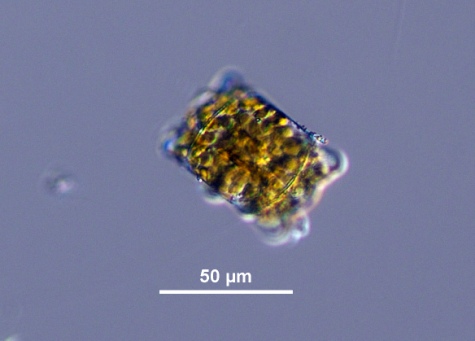



|
 |
Synonym(s)
Homotypic
Expressing the same fundamental type or structure; may or may not be symmetrical (e.g., the two valves of a diatom, where they are the same shape and appearance, but one is bigger than the other). In naming species, a homotypic synonym is one that comes into being when a taxon gets a new name (without being added to an already existing taxon).
(homotypic)Diatoma aurita Lyngbye 1819 (homotypic Close
Basionym
The original name for an organism. In botany, the original published nomenclature from which a new binomial nomenclature is derived for a particular group of organisms (Tindall 1999).
basionym) (Guiry and Guiry 2011)Classification
(Guiry and Guiry 2011)
Lifestyle
Description
Valve
In diatoms, the structurally distinct halves of the cell wall (Becker 1996).
Valves are elliptical to CloseLanceolate
Lance-shaped. Having a wider rounded base and tapering towards the tip.
lanceolate, each with two short and divergent horns that are inflated at the base. Adjacent cells are united by mucous pads on the end(s) of one or both of these horns. The centres of valves are convex but slightly flattened at the top, with zero to several short and divergent CloseSpine
In some diatoms, "closed or solid structures projecting from the cell wall;" in dinoflagellates, solid projections that usually taper to a point.
spines (external tubes of CloseLabiate process
In diatoms, a simple slit in the valve wall with two internal lips, one on each side of the slit. They can be useful in identification because they are positioned differently in different species (Horner 2002).
labiate processes; Cupp 1943, Horner 2002). Chloroplasts are numerous, small, kidney-shaped or elliptical and are located near the valve walls (Hasle and Syvertsen 1997, Kraberg et al. 2010). Cells are yellow-brown in colour (Guiry 2011).Siliceous
Describing the character (i.e., white, shimmery) or chemical presence silicon dioxide (SiO2) as a component of phytoplankton cell covering.
silicified (Cupp 1943). Horns have CloseCostate ocellus
"A plate of silica pierced by closely packed pores" with siliceous ribs between each row of pores (Tomas 1997).
ocelli (Hasle and Syvertsen 1997).Measurements
Apical
(axis, spine) The region of the apex or point. Refers to the most anterior point or region of the cell (HPP 2003).
(apical axis): 10 - 100 μmSmall diameter Close
Transapical axis
In diatoms, the longitudinal axis of the valve.
(transapical axis): 5 - 45 μmHeight Close
Pervalvar axis
The axis through the centre point of the two valves of a frustule. This axis is perpendicular to the valve face.
(pervalvar axis): 15 - 80 μmValve Close
Areola(e)
In diatoms, the regularly repeated hexagonal holes on the valve walls (HPP 2003).
areolae: 8 - 11 in 10 μmBand areolae: 8 - 14 in 10 μm
(Hasle and Syvertsen 1997, Kraberg et al. 2010)
Similar species
Harmful effects
Habitat
Distribution
Cosmopolitan, with highest abundance in Arctic and Close
Boreal
Relating to the area immediately south of the Arctic.
boreal regions (Cupp 1943). Common temperate species (Horner 2002, Kraberg et al. 2010).Much more abundant in late winter and spring than in summer or autumn in Northern European seas (Kraberg et al. 2010).
"Very common at Scotch Cap, Alaska, especially during April and May. Common off southern California but never in large numbers." (Cupp 1943).
Growth conditions
Substrate
Bottom surface. For example, the substrate can be rock, sand, mud, etc.
substrates. Lower temperatures (∼0 °C) facilitate non-adherence behaviour. This may explain why it commonly occurs in benthic habitats during summer and autumn, and yet is common in the ClosePlankton
Organisms that drift at the mercy of the currents.
plankton during winter and spring (Baars 1986). Resting stage germination is most successful around 20 °C with a 16 h ClosePhotoperiod
The amount of time in a day that an organism is exposed to daylight. This varies between seasons, with photoperiods being longer in the summer and shorter in the winter.
photoperiod (McQuoid and Hobson 1995).Environmental Ranges
Temperature range (°C): -0.934 - 24.625
Nitrate (μmol L-1): 0.360 - 24.783
Salinity: 27.251 - 35.625
Oxygen (mL L-1): 4.855 - 8.565
Phosphate (μmol L-1): 0.074 - 2.131
Close
Silicic acid
A general term to describe chemical compounds containing silicon, oxygen and hydrogen with a general formula of [SiOx(OH)4-2x]n. Diatoms polymerize silicic acid into biogenic silica to form their frustules (Azam and Chisholm 1976).
Silicate (μmol L-1): 1.309 - 50.314(OBIS 2011, cited in EOL 2011)
Bloom characteristics
References
Baars, J. W. M. 1986. Autecological investigations on marine diatoms. 4: Biddulphia aurita (Lyngd.) Brebisson et Godey. A succession of spring diatoms. Hydrobiological Bulletin. 19(2): 109-116.
Cupp, E. E. 1943. Marine Plankton Diatoms of the West Coast of North America. University of California Press. Berkeley, California. 238.
Encyclopedia of Life (EOL). 2011. Odontella aurita. http://eol.org/pages/911021/overview. Accessed 11 Nov 2011.
Guiry, M. D. 2011. Odontella aurita (Lyngbye) C. Agardh, 1832. http://www.marinespecies.org/aphia.php?p=taxdetails&id=149050. Accessed 05 Nov 2011.
Guiry, M. D. and Guiry, G. M. 2011. Odontella aurita (Lyngbye) C. Agardh. http://www.algaebase.org/search/species/detail/?species_id=39270. Accessed 05 Nov 2011.
Hasle, G. R. and Syvertsen, E. E. 1997. Marine diatoms. In: Tomas, C. R. (ed.) Identifying marine Phytoplankton. Academic Press, Inc., San Diego. 5-385.
Hendey, N. I. 1964. An introductory account of the smaller algae of British coastal waters. Part 5: Bacillariophyceae (Diatom). In: Ministry of Agriculture, Fisheries and Food. Fishery Investigations Series IV. HMSO, London. 317.
Horner, R. A. 2002. A Taxonomic Guide To Some Common Phytoplankton. Biopress Limited, Dorset Press, Dorchester, UK. 200.
Kraberg, A., Baumann, M. and Durselen, C. D. 2010. Coastal Phytoplankton: Photo Guide for Northern European Seas. Verlag Dr. Friedrich Pfeil, Munchen, Germany. 204.
McQuoid, M. R. and Hobson, L. A. 1995. Importance of resting stages in diatom seasonal succession. Journal of Phycology. 31(1): 44-50.
Ocean Biogeographic Information System (OBIS). 2011. Odontella aurita. http://www.iobis.org/mapper/?taxon_id=753559. Accessed 11 Nov 2011.
